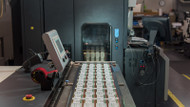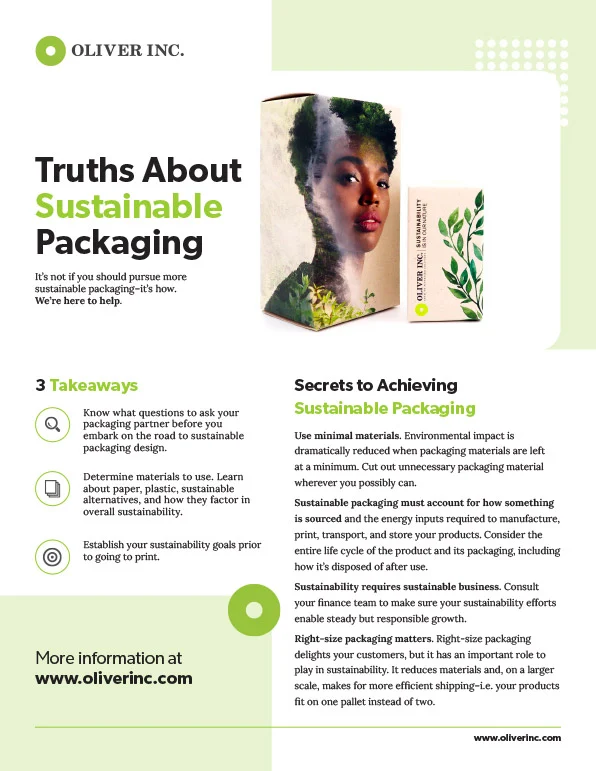The Benefits of Digital Printing for Packaging
Posted by Oliver Inc. on 28th Mar 2024
The advantages of digital printing for your packaging:
- Speed & Agility: Digital printing slashes set-up times and enables swift updates, making it ideal for quick, customized product launches.
- Personalization Powerhouse: Leverages variable data printing for customized, engaging packaging designs that resonate on a personal level with consumers.
- Cost-Effective for Smaller Runs: Saves on set-up costs and avoids large minimum order requirements, benefiting small to medium-sized businesses.
- Enhanced Brand Protection: Incorporating unique anti-counterfeiting features with digital printing safeguards your brand integrity.
- Eco-Friendly Innovation: Digital printing minimizes waste and emissions, aligning with sustainability goals through efficient, small-batch production.
Brand owners regularly look for ways to innovate, including how they produce their packaging. With recent technological developments, digital printing has become a powerful addition to more traditional printing options, among other 2024 packaging trends.
While traditional printing methods remain standard throughout the packaging industry, and for good reason, digital methods come with several undeniable advantages.
What Is Traditional Printing?
Traditional printing methods, such as offset lithography (“offset") and flexography ("flexo"), involve multiple make-ready steps to transfer an original image to a substrate. These methods require the production of a series of plates mounted on a cylinder to transfer ink that forms the desired image when combined on paperboard and other packaging materials.
Plates, labor, and machine setup is costly for small runs, but efficient when producing larger orders. These methods also enable you to add intricate decorative touches to your folding cartons and packaging such as specialty inks, laminates and coatings, embossing/debossing, spot UV printing, hot foil stamping, and inline cold foil stamping.
It’s the quality and cost-effectiveness over medium to large volumes that make offset printing the industry standard. However, the possibilities of digital printing give your brand more options for its packaging.
The Benefits of Digital Printing for Packaging
In contrast to traditional methods, digital printing has taken off in recent years and continues to expand in capabilities.
Provides for faster turnaround. Bypassing much of the heavy set-up time demanded by traditional printing, the simplified process also enables easy updates. Printers change a digital file in a matter of clicks instead of manufacturing a new plate for offset printing.
Digital printing is best suited for small to medium print runs, which means it can be a preferred method if you’re introducing new or customized products on a much faster timeline.
While digital printing is a viable option for most short-run print jobs—special occasions, prototyping, or other considerations—its modern capabilities really show in fast turnarounds.
Makes the most of variable data printing. Being able to customize packaging through variable data printing has opened up new opportunities for you to engage with your customers in more personalized ways. Digital printing, with fewer moving pieces, is more agile than offset in this regard.
You can produce folding cartons to celebrate special occasions, say thank you to loyal customers, or design packaging specific to particular regions. It’s a way to blend your packaging and marketing strategies.
Saves on costs for low- and medium-volume runs. Reduced set-up time saves money on the front end. And since these are not massive bulk orders, smaller businesses can afford to print without having to meet the higher and more expensive print thresholds of traditional printing.
Implements anti-counterfeiting. Digital printing helps protect your brand against counterfeiting by incorporating overt and covert solutions on your packaging. Digital inks can produce unique marks or microtext that are quite impossible to replicate.
Increases sustainability. Advancements in technology mean digital printing produces both less waste and lower emissions, including the Heidelberg Speedmaster press employed by Oliver Inc. Since digital printing is cost-effective for small print runs, you can reduce the amount of materials needed during the proofing process when rolling out new packaging.
Your brand can save money while reducing its ecological impact.
Plus, you can further enhance your green efforts by integrating digital printing with other sustainable packaging design printing principles, such as right-size packaging and sourcing timber-based products from responsibly managed forests as certified by the nonprofits Sustainable Forestry Initiative (SFI) and Forest Stewardship Council (FSC).
Be sure you collaborate with a printing and packaging partner who has the right certifications.
Approaching the Digital Printing Process
While eleventh-hour printing and customization are a huge benefit, digital may not always be the best method for you. For example, offset printing has the advantage of cost-effectiveness with large print runs, especially those with advanced decorative effects and specialty coatings.
This is why it’s important to collaborate with an experienced printer who can navigate you through the various printing options and outline their folding carton design process upfront.
They might advise you in a few ways:
Manage expectations. They’ll recommend digital printing when it’s appropriate for your brand, but won’t force your company into using or abandoning traditional methods. Try digital out in its most effective ways, such as in a short-run test or personalized print job.
Faster isn’t always cheaper. Digital printing’s true strength is speed and getting new products to market. While time efficiency can save on costs, it isn’t necessarily a less expensive option. A knowledgeable printer will help you determine the most cost-effective printing method for you.
Simplify the workflow. Your printer should set out a clear plan, ensuring you understand which traditional steps are no longer relevant and how automation or artificial intelligence integrates with the remaining manual steps to avoid bottlenecks.
Examine all price factors. Your printing partner should compare prices between running the same job through a digital printer versus an offset printer, accounting for total expenses, including all the machinery tools for both platforms. That will help reveal a more comprehensive comparison, ensuring your company makes the smartest decision.
While offset printing retains its primary role in packaging, digital expands the available options with added benefits, including fast turnarounds, simplified workflows, variable data printing, flexibility, and excellent print quality.
Just be certain your company gives careful consideration to everything that goes into a comprehensive comparison between digital and offset printing. What works for one job may not work for another.






